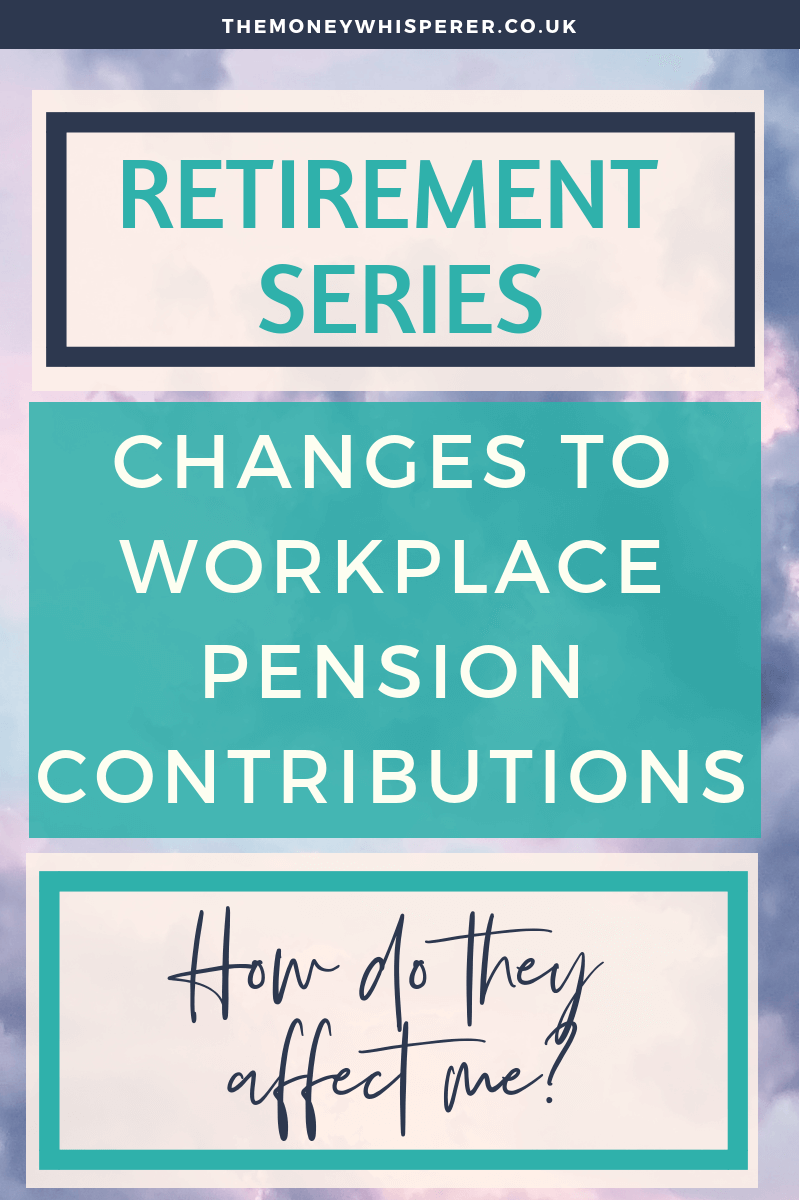This post may contain affiliate links which means that if you click through to a product or service and then buy it, I receive a small commission. There is no additional charge to you.
Changes to workplace pension contributions: how do they affect me?
I’ve been working hard this year producing content around retirement planning as I believe it’s something that really needs hammering home. Recent research from the Scottish Widows Women and Retirement report suggests that many women aren’t planning their pensions early enough, with a third of women not saving adequately, compared to 46% of men their age.
This is worrying, given that statistically, women live longer and earn less.
If you are employed, auto-enrolment in to your workplace pension means the process of actually enrolling in a pension scheme is taken care of for you, plus there are minimum contribution requirements. This is a GREAT start on the journey towards ensuring you have enough money for later life.
I have teamed up with Mumsnet and Scottish Widows in this post to highlight the changes to workplace pension contributions which come in to effect this month, and how they could affect you.
What is auto-enrolment?
Auto-enrolment is a Government initiative to help more people save for later life through a pension scheme at work.
Whilst historically a lot of larger employers provided a workplace pension scheme for their employees, this wasn’t the case for smaller employers. Since the introduction of auto-enrolment, every employer has to offer a workplace pension, even those with only one employee.
Auto-enrolment makes it compulsory for employers to automatically enrol their eligible workers aged 22 up to state pension age earning over £10,000 per year into a workplace pension scheme that the employer also contributes towards.
If you have a job earning between £6,032 and £10,000 per year, you won’t be automatically enrolled into your workplace pension. However, if you choose to opt in, your employer will pay in too.
Employees can opt out of the scheme if they chose but be re-enrolled every 3 years.
Minimum contributions
The Government has set minimum levels of contributions that must be paid to the workplace pension scheme by you and/or your employer.
What goes in to your workplace pension is based on three separate contributions:
- Your employer must pay some of the minimum total contribution.
- If your employer doesn’t pay all of the minimum total contribution, you will need to make up some of the difference. Your employer will tell you how much this is.
- The Government will also pay into your pension pot by giving you tax relief on your contributions.
Prior to April 2019, the minimum contribution that could be paid into automatic enrolment schemes was 5% – split between the employee, their employer and the taxman.
For a basic rate taxpayer to achieve the minimum 5% contribution, they would typically have to personally contribute 2.4%. The additional 2.6% comes from tax relief (0.6%) and employer contributions (2.0%).
Tax treatment depends on your individual circumstances; if you are a higher rate tax payer, you can currently claim even more tax relief.
Changes to the auto-enrolment scheme in April 2019
In April 2019, minimum contributions to workplace pensions will increase from 5% to 8%. If you hear the term ‘auto-enrolment step up’ being used, this is the same thing.
If the total that you, your employer and the taxman currently contribute to your pension is currently less than 8% then you’ll all put in a little more when this change comes into effect.
When the changes come into effect, the temptation might be to simply opt out and stop saving for retirement all together. Please think about your future carefully at this point.

See the step up as a huge positive
Since the start of my series on retirement planning, I’ve heard from lots of you, especially women, about the challenges you face in relation to prioritising your future self when you have more immediate needs for your money. Children, mortgages, bills, cars, holidays…
I know first-hand that when faced with a reduction in salary after children coupled with childcare costs, paying in to my pension was not a priority.
With all the financial challenges a family faces, the increase in workplace pensions contributions could make someone even more likely to opt out, to avoid paying the extra that they now need to contribute.
However, rather than seeing increased personal monthly contributions as a negative, I want to help you see the long-term benefit of them. I wish someone had been in my ear about this a few years ago!
Opting out could have serious implications for your financial future
For many families, when the adult who has been caring for a child (typically the mother) returns to work, often their salary is eaten up in large part by childcare costs. On the face of it, for many it may seem that a return to work is not worth it financially. Now with an increase in pension contributions taking another bit of your take home salary, it can feel as if the odds are stacked against you.
However, I want you to reframe this. Instead, think about the huge benefit that being employed and paying in to a pension has in terms of your long-term financial health.
Being employed now provides not just income today, but also a means of investing for your future.
With the latest step up in pension contributions, you will be receiving significant amounts of free money from both your employer and the Government in the form of tax relief. This money, along with your contribution, will grow over time in your pension and provide you with money for your future.
I am not suggesting that combining being working parents, childcare and managing a family budget is easy by any stretch of the imagination. But it is so easy to live in the present and for women especially, we prioritise everyone else except ourselves. I hope to make you consider your future self in your decision making.
The increase to minimum contributions is great news for everyone, especially women who haven’t prioritised saving for retirement to this point. It’s going to give a huge boost to the money going in to their pension savings, and more going in means more money for compound interest to work its magic on.
Scottish Widows have some great infographics to help illustrate the impact of the additional 3% – check these out here. As an example, someone earning £27,000 per annum would only pay an extra £36 into their pension a month.
For a 25 year-old, this could potentially mean an extra £55,100 in their pension pot by the age of 65.
What difference does my increased contribution make?
I am a numbers person and time and time again I see the power of big numbers helping shock people in to action when it comes to making financial decisions.
You can put your personal details in to this handy calculator to see what the impact of the changes to workplace pension contributions could be for you personally based on your age and salary.
The most important thing is to stay opted in. You’ll benefit from so much free money; tax relief and your employer’s contributions.
Planning for your future
Continuing to actively save in to your pension, whatever your age, is so vital. It enables you to stay in control of your future.
If you want to learn more about planning for your future, the Taking On Your Future Together hub provides a wealth of information on a myriad of issues around retirement including:
- Understanding your personality when it comes to saving, forward thinking etc. Are you a mindful planner or a savvy saver? Take 2 minutes to find out your pension personality and get tailored next steps to retirement.
- The different ways in which pension savings can be taken in to account if you are parting from a partner.
- Ways to trace a lost pension.
- Protection products beyond pensions.
It’s never too early or too late to start planning for a financially independent future. Go and take a look.
On the Mumsnet Facebook Live with Scottish Widows this week, I was astounding by this fact and I want to leave it with you to hopefully hit home the power of taking action when it comes to your finances:
‘An extra 2% contribution to your pension in your 20s could give you the opportunity to take a 6 year break from employment when you want to have kids.’
Wow!
This post is sponsored by Scottish Widows.

